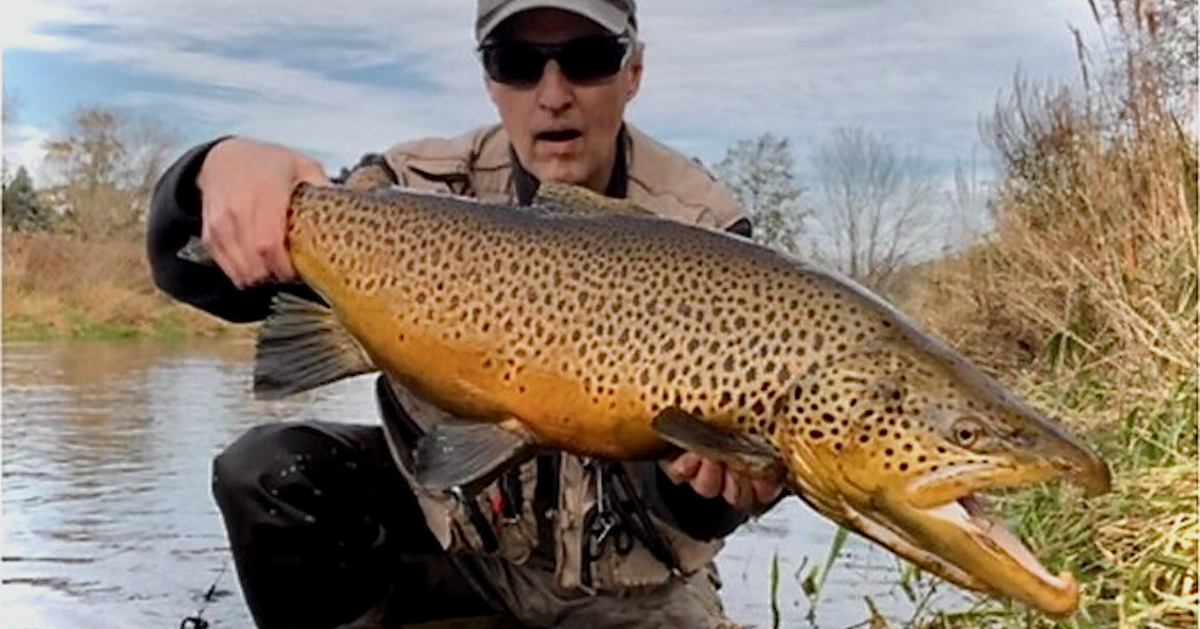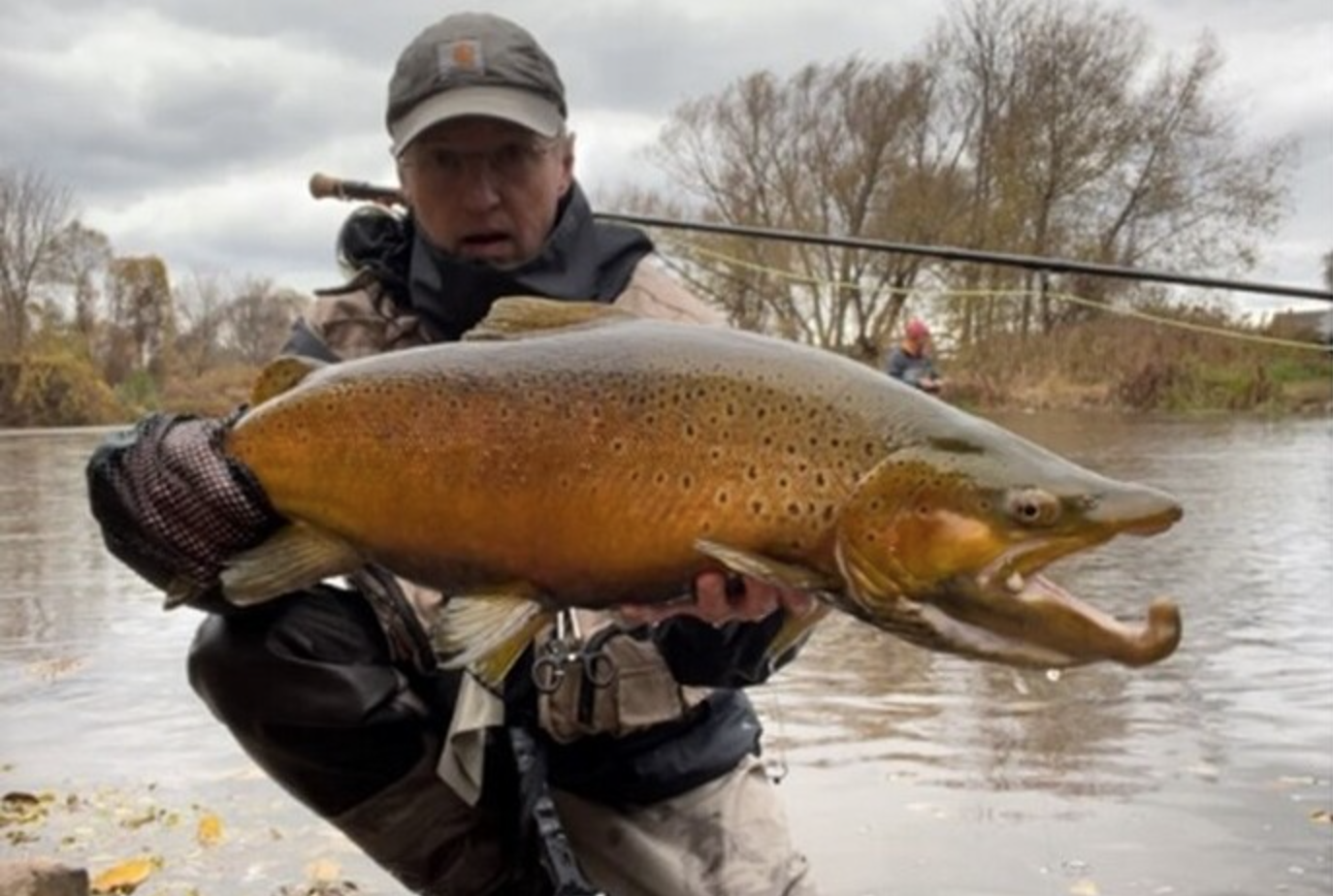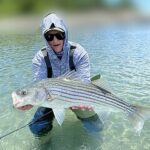At the height of the fall – when the landscape displays the most vibrant red and orange colors, and the air is crisp and cool, often affected by wind and rain – giant brown trout start moving up numerous tributaries along the Lake Ontario shoreline to spawn.
This is the time when anglers have a unique opportunity to land a double-digit, pristine pre-spawn brown trout on the fly, in bodies of water ranging from small creeks just a few feet wide, to large rivers.
I first shared this article on MFCC back in January here inside the Fly Fishing category of our forum. Today, I'm happy to have it published here on the My Fishing Cape Cod blog.
History and Species Information
The brown trout was brought from Germany and introduced to Lake Ontario in 1913. The most famous strain of brown trout that was introduced is called seeforellen (sea trout in English), which is known as the football brown.

The author with one of 60 brown trout caught during his most recent fly fishing expedition to Lake Ontario.
This strain grows larger, up to about 30 pounds, and lives longer than other strains, which makes it an exciting species to target. The brown trout is now considered a naturalized species in Lake Ontario, with a good number of both wild and stocked fish.
Understanding Tributary Types
Before planning a brown-trout trip to a Lake Ontario tributary, it is essential to understand its basic nature. Is it a run-off creek or a spring-fed one?
Run-off Creeks
A run-off creek typically becomes unfishable after a big rainstorm, totally blown out with high levels of muddy water. Although this is a challenge, it does present an advantage. The fishing pressure tends to drop considerably and the fish get rested for a period of time. When the water level has receded and cleared up, fishing can be spectacular.
Spring-Fed Creeks
A spring-fed creek, on the other hand, is less weather dependent and remains relatively clear for most of the time, and thus offers fly anglers more consistent fishing conditions. The downside, perhaps, is that these creeks tend to be more pressured.
Temperature Variations
Another thing that must be considered is that smaller creeks are quite sensitive to temperature variations, which impacts the fishing considerably. With that in mind, try to time your fishing to periods of steady or increasing water temperature. This is especially important later in the season when the water temperature often hovers just above freezing.
It is for these reasons, it is critical to understand the creek you are planning to fish. Monitoring the water temperature, level, flow, and turbidity on a daily basis is a critical prerequisite for successful fishing.
Early Season Tactics
Provided there is adequate water flow in the tributaries, and the water temperature and conditions are close to ideal, brown trout will typically start moving up in late October and early November to spawn. With the tail end of the salmon spawn, the browns encountered early on are opportunistic feeders, primarily focusing on salmon eggs.
My first brown last fall was a smaller fish sitting behind a salmon redd feeding on eggs. Dead drifting an egg fly under an indicator got it done. Up to that point, fishing had been below average because of a long dry spell, which resulted in low water levels and flows that prevented the browns from moving up the tributaries. At the time, little did I know that the next couple of weeks would end up being very special. Not long after, the tributaries did receive substantial injections of water, without being blown out, which initiated excellent runs of brown trout, taking below-average fishing to world-class fishing.
Peak Season Success
During the next couple of weeks, I landed about sixty browns, including a few double-digit ones and a personal best. Many of these browns were still in pre-spawn mode, looking pristine and being a handful to deal with. Although the brown trout is not famous for long reel-screaming runs, the big ones use their weight and current to give you a memorable fight.
Most browns were landed by dead drifting an egg fly in either orange or Oregon-cheese color under an indicator. A couple of split shots were often necessary to bring the egg fly down to the bottom and control the drift for the most effective and natural presentation. The disadvantage is that the indicator can spook fish when the water is low and clear.
If you are looking for a good eat, at the height of the spawn, I recommend that you fish buckets (small pools) behind redds. Fish in these buckets tend to not focus on spawning and will snack on eggs that have saturated the system. At this point, the hens (see images below) are generally perfect specimens of the football brown.

The author with a couple "hens" that were caught once the tributaries received substantial injections of water (without being blown out). Prior to the influx of water, the fishing in the tributaries had been quite difficult.
Fish Behavior and Cover
One thing that never ceases to amaze me is that at the height of the spawn, the number of browns visible in the system at dusk and dawn can be staggeringly high, while it can look like a dead zone during the day. This is especially true during a clear day when the water is low and clear.
The browns are incredible "ninjas" and will find excellent cover, if necessary, provided by undercut banks, overhanging tree limbs, log jams, bridges, and deep riverbed notches. Broken water surface and even cloudy days provide good cover. In addition, when fish are heavily pressured, they will most certainly seek cover and not be receptive to flies. In these situations, fish will hold tightly to cover in a holding pattern.
I will never forget one morning when I had about two dozen browns in front of me, including a couple in the double-digits, both spawning on a redd slightly upstream and sitting in a pool behind the redd feeding on their own eggs. For about an hour in the morning, I was alone and had excellent fishing. This was followed by a long period of not seeing a single brown, primarily caused by an increased number of anglers on the water and sun being high up in the sky. It was incredible to see how quickly they disappeared.
Memorable Catches
Last fall, two browns stood out from the rest. Both fish were encountered in a similar fashion. The first one was a giant buck and a personal best, which I encountered an early morning under a bridge in a deep pool about 100 yards downstream of a well-known redd.
As the fishing pressure around this redd had been high this morning, and thus pushed the fish both upstream and downstream, I decided to fish the downstream pool. This turned out to be a good decision. Being alone, I quickly found and landed a few solid browns from about 6lb to 9lb. While dealing with these browns, I had seen a large shadow moving around under the bridge.
At first, I assumed it was a 20lb-class King but not long after my indicator went down and I hooked something very solid that I could not move at first. For a second, I thought the classical thought that I had hooked bottom, but a couple of seconds later I felt a few very heavy head shakes while the fish started slowly moving upstream.
A few more seconds later, the fish came up to the surface and rolled, which made my heart stop. I estimated it was a 15lb+ buck. It turned around and came back to the pool and decided to "anchor" itself to the bottom. It didn't want to move for the next few minutes, and with my 7wt rod and 8lb-tippet there wasn't much I could do except try to stay relatively calm.
Another minute, perhaps two, passed before he started showing signs of fatigue. He made another upstream run to shallower water but turned around once again to the pool. This time, it was tired enough I could steer it toward the bank and I was fortunate to net the fish tail first on the first try. I was sitting there watching this amazing fish in the net in total disbelief and with adrenaline over my ears. What a rush! These are the very rare moments that I am seeking when being out fishing. I estimated the brown to be 34-35" long. Having very broad shoulders, I also estimated it to be well above 15lb.

The author with an estimated 15 pound 34-35 inch long brown that gave him a run for his money!
Another Trophy Brown
The other brown that stood out was another double-digit buck, probably the most gorgeous fish I've landed. After hours of grinding covering a large area looking for solitude, rested waters, and good eats, I eventually found a group of fish sitting in a deep pool just behind a redd.
At first, I didn't think any of these fish looked that special. As the leading edge of the pool had a sharp drop-off, I added a split shot and started dead drifting an egg fly without targeting any fish. On the second drift, this larger buck ate the fly and realized immediately it was hooked and took off downstream. This was the time I realized it was a better fish.
Trying to keep up and be as close as possible to the fish, I was stumbling down the creek over rocks and boulders, while keeping the rod tip high up to reduce the risk of having the tippet cut by a rock. As I am not the most gracious person around, it must have been hilarious seeing me stumbling down that creek with my hands and rod above my head.
When I had kind of caught up with the fish about 100 yards downstream, it decided to turn around and move upstream. After a few minutes' fight, it finally started to get tired allowing me to lift it from the bottom of the pool and steer it toward the bank where I got a good grab of the tail. Sitting on my knees watching this gorgeous, double-digit buck will be a memory for life.

Another gorgeous double digit "buck" brown trout.
Late Season Strategies
As the season and spawn progress, the brown trout put their feed bags on and widen their diet to include baitfish, nymphs, worms, and leeches. This is the time when you can have some productive fishing swinging streamers, wet flies, or intruders. This is an amazing type of fishing because that grab on the swing is very special.
Although swinging a fly is not as effective as dead drifting an egg fly or nymph, it is an effective way of covering water, especially when the water is clear. However, when the water is murky, it is important to slow down the swing presentation to improve the chances of a fish seeing your fly.
In addition, when fishing pressure is high, the browns are seeing tons of egg patterns, streamers, and people all day long, they will be more tentative in all of their actions. In that case, one has to spend more time in a given section of water, trying different patterns, sizes, and subtle colors. Last fall, I was fortunate to find a handful of browns (about 1 in 10), which were willing to eat a streamer on the swing even though fishing pressure was relatively high.

These two browns were landed on the swing using an egg sucking leech.
Winter Fishing
Given that some fish will stay in the creek the entire winter, productive fishing can be had this time of the year. Once the water temperature has plummeted, browns will generally be found in the winter holding areas. As their metabolism has slowed down and the fact there is more dissolved oxygen in the water than at any other time of the year, they will be found in the slower-moving water with little turbidity. The water will typically be deep, at least two feet.
Now is the time to be cognizant of the specific conditions for that day and the overall trends because those will direct your decisions. As you will have to put the fly right in front of the brown, it is important to find areas that will possibly funnel fish into one spot like in deep, slow-flowing tailout of a deeper pool.
In addition, one has to slow down the presentation. This also means one has to spend more time fishing a particular spot. Slowly dead drifting a nymph, egg fly, or an egg-sucking leech can work well during this time of the year. Dead drifting or swinging a 3" baitfish pattern can also be effective, especially in the white color (or chartreuse for murkier waters). However, I do not recommend swinging a streamer unless the water temperature has increased a few degrees, making the browns a bit more active.
A Winter Success Story

A nice hen caught during the middle of the winter.
One "winter brown" that I caught a couple of years ago stands out in particular. After hours fishing in close-to freezing water temperatures, I only connected with one fish that broke me off. It was a cloudy day and water was somewhat murky, making me think I had to present the fly very slowly, close to structure.
With serious cloud cover, I figured that the fish might also hold close to the edges of the creek. That was my tactic for the day, which resulted in several lost flies. With tired and cold hands, it became increasingly difficult to tie on a #10 egg fly on an 8lb tippet.
I didn't give up and eventually hooked up with a nice hen in a deep hole at the tailout of a bigger pool, just three feet in front of me. When hooked, the brown came up to the surface rolling around, which raised my pulse to probably unhealthy levels.
After a couple of minutes of fight, she started to be ready for the net, but each time I tried to net her with a short-handle net, she made a run. On the fourth try, I got her in the net, which made my day. She was the only fish I landed that day, which made it extra sweet. Also turned out to be my season best that year.
Reflections on Brown Trout Fishing
The journey of pursuing Lake Ontario brown trout throughout the seasons is a testament to the dynamic nature of fly fishing. From the vibrant autumn days when pre-spawn browns make their powerful runs upstream, through the technical challenges of winter fishing, each season presents its unique rewards and challenges. Success on these waters demands not just skill with a fly rod, but also a deep understanding of the fish's behavior, habitat preferences, and seasonal patterns.
What makes brown trout fishing in Lake Ontario's tributaries truly special is the combination of accessibility and world-class opportunities. Where else can an angler find themselves casting to trophy-class fish in intimate settings, sometimes in creeks narrow enough to step across? The seeforellen strain has created a unique fishery that rivals destinations across the globe, yet remains somewhat under the radar.
Whether you're dead-drifting egg patterns during the fall spawn, swinging streamers in the post-spawn period, or meticulously working winter holding water, the pursuit of these magnificent fish will challenge your skills and reward your persistence. Each successful catch is a story unto itself, and even the ones that get away become part of the rich tapestry of experiences that keep us coming back to these waters, season after season.
Access More Fly Fishing Content
Visit the Fly Fishing category of our forum for the latest fly fishing posts and reports.


So, I live and grew up in Rochester, NY. Fished local tribs my childhood, and early adulthood. Not far east, but south shore … like surfcasting at ice out in March. Some local casting in Oct – Nov. You def connected me to some earlier years, so thank you 🙏🏻. Your write up is so intricate, I love it, really paints a picture of something you love. Thanks !
Really great to hear my article connected to your earlier years.
Great article. Glad u had such a good year.
What would casting at the mouth of the tributaries be like at night targeting the trout before they move up stream?
Fishing can be fantastic just outside the tributary mouths, both during day and night, especially when the water level and flow are low in the tributary. Fish will stage up in the vicinity of the mouth just waiting for the water conditions to be right in the trib. Folks have done really well fishing from jetties close to a tributary, throwing small spoons and swimming plugs. If you have a boat, fishing can be off the chart.
Awesome browns!! World class brown fishery. I love catching big Lake O browns!
Thanks Johan! An inspiration as always!! Keep em coming!